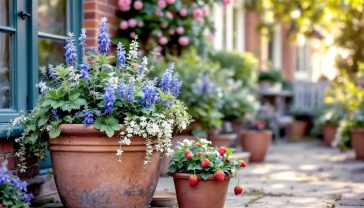Autumn Gardening: How to Prepare Your Garden for a Restful Winter
Your definitive guide to autumn gardening. Learn the essential jobs for September, October, and November to ensure your garden rests well and bursts into life in spring.

This post may contain affiliate links. If you make a purchase through these links, we may earn a commission at no additional cost to you.
Autumn in the garden isn’t an ending. It’s not the sad, slow drawing of the curtains on another year of colour. If you ask any seasoned British gardener, they’ll tell you a secret: autumn is the most important season of all. It’s the grand preparation, the tucking-in, the thoughtful planning that separates a good garden from a truly spectacular one.
That crisp chill in the morning air and the golden, slanting light of the afternoon aren’t signals to down tools and retreat indoors. They’re a call to action. The work you put in now, between September and November, is your investment in the future. It’s the difference between a sad, muddy patch in February and a garden that’s ready to explode with life at the first hint of spring.
Think of it as putting your garden to bed for a long, restful sleep. You’re making sure it’s warm, fed, and safe from the harshness of winter, so it can wake up refreshed and ready to go. This guide will walk you through everything you need to do, from the big clear-up to the secret jobs that give you a massive head start next year. Let’s get our hands dirty.
The Great British Autumn Clean-Up: Tidying Borders and Beds
The first, most obvious job is to deal with the glorious mess that summer leaves behind. Your borders, once bursting with life, might now look a bit tired and leggy. It’s time for a gentle but firm tidy-up.
Clearing Out Summer’s Leftovers
Your annual plants—the ones that live for just one season, like cosmos, petunias, and zinnias—have done their job. Once they’re blackened by the first proper frost, or are clearly past their best, it’s time to pull them up. Don’t just bin them, though. If they’re free of disease (no nasty mildew or rust), chop them up and add them to the compost heap. They’re full of goodness that you can give back to the garden later.
The same goes for finished vegetable crops. Old beanstalks, yellowing courgette plants, and frost-hit tomato vines can all be cleared away. This isn’t just about tidiness; it’s about hygiene. Leaving rotting plant matter around can create a cosy home for pests and diseases to spend the winter, ready to cause trouble next spring.
To Tidy or Not to Tidy? A Word on Wildlife
Now, here’s a modern gardening debate: how tidy should you really be? The perfectly sterilised, bare-earth gardens of old are falling out of fashion, and for good reason. A bit of ‘mess’ is a lifeline for wildlife.
Many perennial plants, like echinacea (coneflowers), sedums, and ornamental grasses, have beautiful seed heads that look magical when dusted with frost. More importantly, they provide a vital winter food source for birds like goldfinches. The hollow stems of plants also offer a safe place for insects like ladybirds to hibernate.
So, what’s the compromise?
- Leave the good stuff: Keep any plants with strong, structural seed heads standing. You can always tidy them up in late winter or early spring.
- Clear the mushy stuff: Anything that collapses into a slimy mess (like hostas or daylilies) can be cut back to the ground. This prevents slugs and snails from finding a winter holiday home.
- Be gentle: When you’re clearing, try not to stampede through the borders. You might be disturbing a sleepy hedgehog or a hibernating frog.
The Magic of Leaf Mould: Don’t Waste Those Leaves
When the trees start shedding their leaves, don’t see it as a chore. See it as a free gift. Raking leaves off the lawn is important—if you leave them, they’ll suffocate the grass and create dead patches. But whatever you do, don’t throw them away.
Autumn leaves rot down to create ‘leaf mould’, a fantastic soil conditioner that gardeners call ‘black gold’. It improves soil structure, helps it hold moisture, and provides a wonderful habitat for beneficial worms and microbes.
Making it is incredibly simple:
- Gather your leaves. Any type will do, though tougher ones like oak and sycamore take longer to break down.
- Contain them. The easiest way is to put them in black bin bags. Pack them in, add a splash of water to keep them damp, and poke a few holes in the bag with a fork.
- Wait. Store the bags somewhere out of sight for one to two years. After a year, you’ll have a crumbly, half-rotted mould perfect for spreading on borders as a mulch. After two years, you’ll have a fine, dark material you can use in potting mixes.
If you have a lot of leaves, you can build a simple wire cage in a shady corner of the garden and just pile them inside. It’s the easiest, most rewarding job in the autumn garden.
Feeding the Future: Preparing Your Soil for Spring
With the beds cleared, you can now see the most important part of your garden: the soil. Winter is the perfect time for it to rest and recover, and you can help it along.
Why Healthy Soil is Everything
Think of your soil as a bank account for your plants. Throughout spring and summer, your plants have been making withdrawals, taking up nutrients to grow strong. Autumn is your chance to make a big deposit, replenishing that goodness for the year ahead. Healthy, well-fed soil means stronger, healthier plants that are better able to resist pests and diseases.
The Gardener’s Secret Weapon: Mulching
If you do only one thing for your soil this autumn, make it this: add a mulch. A mulch is simply a layer of organic matter spread over the surface of the soil. It acts like a warm duvet for your garden beds over winter.
A good, thick mulch (around 5-10cm or 2-4 inches deep) does several amazing things:
- Protects the soil: It shields the soil from being battered by winter rain, which can wash away nutrients and compact the surface.
- Suppresses weeds: It stops annual weed seeds from getting the light they need to sprout in spring.
- Feeds the soil: As the mulch slowly breaks down, worms will drag it down into the soil, adding vital nutrients and improving its structure.
- Keeps moisture in: It helps the soil retain water, making it less prone to drying out.
What can you use as a mulch?
- Homemade compost: The absolute best thing for your garden. It’s full of life and nutrients.
- Well-rotted manure: You can buy bags of it from garden centres. Make sure it’s ‘well-rotted’, as fresh manure can scorch plant roots.
- Leaf mould: As we discussed, it’s a fantastic soil conditioner.
- Chipped bark: This breaks down more slowly, so it’s great for paths or around shrubs.
Spread your chosen mulch over the bare soil in your borders, around the base of shrubs, roses, and perennial plants. Don’t pile it right up against the woody stems of plants, as this can encourage rot.
To Dig or Not to Dig? The Great Debate
For generations, gardeners would dig over their vegetable patches in autumn, leaving big clods of earth for the frost to break down. This can help with heavy, clay soil.
However, the ‘no-dig’ method is becoming increasingly popular. The idea is that digging disturbs the delicate ecosystem of worms, fungi, and microbes that keep your soil healthy. No-dig gardeners simply spread a thick layer of compost or mulch on the surface and let the worms do the work of incorporating it.
There’s no right or wrong answer. If you have very heavy, compacted clay soil, a one-off dig can help to break it up. But for most established gardens, simply applying a thick mulch each autumn is easier and often better for the long-term health of your soil.
Putting the Lawn to Bed: Autumn Lawn Care
Your lawn has had a tough summer of barbecues, paddling pools, and endless mowing. Autumn is the time to give it some TLC to ensure it stays green and healthy through winter.
The Final Mow of the Year
You can continue to mow your lawn through autumn, but raise the height of the blades. A slightly longer lawn is tougher and more resilient to the cold. As growth slows down, you’ll mow less and less. For the final cut of the year (usually in late October or November), leave it about 4-5cm (around 2 inches) high. Don’t scalp it short.
Scarifying and Aerating: Helping Your Lawn Breathe
Over the year, a layer of dead grass, moss, and other debris, known as thatch, can build up at the base of your lawn. This can stop water and air from getting to the roots. Scarifying is just a fancy word for raking this stuff out with a spring-tined rake. It can look brutal, but your lawn will thank you for it.
If your lawn gets a lot of use or is on heavy soil, it can become compacted. Aerating means making holes in it to let air, water, and nutrients get down to the roots. For a small lawn, you can just push a garden fork into the ground every 15cm or so and give it a little wiggle. For larger lawns, you can hire a machine or use special spiked shoes.
Autumn Feed: The Right Meal for Winter
Don’t use a spring or summer lawn feed in autumn. They are high in nitrogen, which encourages leafy growth—the last thing you want before the frosts arrive. An autumn lawn feed is specially formulated. It’s low in nitrogen but high in potassium and phosphates, which strengthen the roots and help the grass resist disease over winter.
Planting for Spring’s Surprise: Bulbs, Biennials, and More
Autumn isn’t just about tidying up; it’s also a fantastic time for planting. It feels like an act of faith, burying these funny-looking bulbs and tiny plants, but it pays off spectacularly in spring.
A Carpet of Colour: Planting Spring-Flowering Bulbs
This is one of the most joyful autumn jobs. Planting bulbs like daffodils, tulips, crocuses, and alliums is like burying treasure for your future self to find.
- When to plant: Daffodils, crocuses, and hyacinths are best planted in September and October. Tulips are the exception—plant them in November. This later planting helps to avoid a fungal disease called tulip fire.
- How to plant: The general rule of thumb is to plant a bulb at two to three times its own depth. So, a 5cm tall daffodil bulb should be planted with its base 10-15cm below the surface. Plant them with the pointy end facing up!
- Where to plant: You can plant them in drifts in your borders, in pots and containers, or even ‘in the green’ in your lawn for a natural look. Just remember where you put them so you don’t accidentally dig them up later.
Getting a Head Start: Sowing Hardy Annuals
Some annual flowers are tough enough to be sown in autumn for an early display next year. These hardy annuals, like cornflowers, poppies, and nigella (love-in-a-mist), will germinate and produce small, sturdy plants that can withstand the winter. They will then have a massive head start in spring, flowering much earlier and more strongly than those sown later. Simply scatter the seeds on a patch of bare, raked soil and water them in.
The Best Time for a Big Move: Planting Trees and Shrubs
Autumn is the perfect time to plant new trees, shrubs, and roses, or to move existing ones. The soil is still warm from the summer, but the air is cooler and wetter. This gives the plants plenty of time to grow a strong root system before they have to worry about producing leaves and flowers next year. Planting now means less watering for you and a stronger, more established plant come spring.
The Autumn Haircut: Pruning and Cutting Back
It can be tempting to go wild with the secateurs in autumn, but you need to be careful. A bad haircut now can mean no flowers next year.
What to Prune Now (and Why)
Some plants do benefit from an autumn trim.
- Roses: Give climbing and rambling roses a light prune to shorten long, whippy stems that could get damaged by winter winds. For bush roses like hybrid teas and floribundas, you can reduce their height by about a third for the same reason. The main, hard prune can wait until late winter.
- Fruit Trees: You can prune apple and pear trees once all the leaves have fallen. This is called ‘winter pruning’ and it encourages fruit growth. However, stone fruit trees like plums and cherries should only be pruned in summer to avoid a nasty disease called silver leaf.
- Herbaceous Perennials: As mentioned, you can cut back any perennials that have died down into a mushy mess.
Hold Your Shears! What NOT to Prune in Autumn
This is really important. Do not prune any shrubs that flower in spring or early summer. Plants like Forsythia, Weigela, Philadelphus (mock orange), and spring-flowering clematis produce their flowers on growth they made this year. If you prune them now, you’ll be cutting off all of next year’s flowers. The rule is to always prune these shrubs immediately after they have finished flowering.
Also, avoid pruning anything borderline hardy, like Penstemons or Fuchsias. The top growth, even if it looks a bit scruffy, provides protection for the plant’s crown from frost. It’s better to leave it on until spring.
Protect and Survive: Shielding Your Plants from Winter’s Bite
The British winter can be unpredictable. Mild, wet weeks can be followed by a sudden, sharp frost. You need to be prepared to protect your more delicate plants.
Wrapping Up the Tender Ones
Tender perennials like salvias and dahlias, or architectural plants like tree ferns and bananas, won’t survive a hard frost without help.
- For dahlias: After the first frost has blackened the foliage, cut the stems down to about 15cm (6 inches). Carefully dig up the tubers, brush off the soil, and store them somewhere cool, dry, and frost-free (like a shed or garage) in boxes of sand or dry compost.
- For plants in the ground: You can protect the crown of tender plants by piling a very deep, dry mulch over them—think a thick blanket of bark chips, straw, or even bracken fronds. For taller plants like tree ferns, you can wrap the trunk and crown in horticultural fleece.
Moving House: Bringing Pots Indoors
Any plants in pots that aren’t fully hardy, like pelargoniums (geraniums), fuchsias, or olive trees in colder parts of the UK, should be moved to a more sheltered spot. This could be against a house wall, in a cold greenhouse, or a porch. The key is to protect their roots from freezing solid in the pot, which is often what kills them. Raise pots off the ground onto ‘pot feet’ or bricks to stop them getting waterlogged.
The Final Harvest: Enjoying Autumn’s Bounty
Autumn is also a time of great reward in the kitchen garden.
What to Pick Now
There’s still plenty to harvest. Maincrop potatoes, pumpkins, and squashes will be ready. Apples and pears should be picked before the first frosts. It’s your last chance to get runner beans, and you might still have autumn-fruiting raspberries. Hardy veg like kale, leeks, and Brussels sprouts will actually taste better after a frost, so they can stay in the ground.
Storing Your Produce for the Months Ahead
Knowing how to store your harvest is key.
- Apples and pears: Wrap each fruit individually in newspaper and store them in a cool, dark, frost-free place. Check them regularly and remove any that are going soft.
- Potatoes: Let them dry out, then store them in paper or hessian sacks in a dark place. Light turns them green and poisonous.
- Onions and garlic: Dry them out fully before storing them in net bags or by plaiting them into traditional strings.
A Helping Hand for Wildlife: Your Garden as a Winter Haven
As natural food sources become scarce, your garden can be a five-star hotel for wildlife.
- Homes for Hedgehogs: If you find a pile of leaves and logs, leave it be—it could be a hedgehog hibernating. You can even buy or build a special ‘hedgehog house’ and place it in a quiet, sheltered corner.
- Feeding the Birds: Put out high-energy food like fat balls, sunflower seeds, and peanuts in feeders. Importantly, clean your bird feeders and bird bath regularly to prevent the spread of disease.
- Pond Life: Drape a net over your pond to stop it filling up with falling leaves, which will rot and pollute the water. If it’s likely to freeze, float a ball in the water to stop it freezing solid, which allows toxic gases to escape.
The Tool Shed Tidy: Cleaning and Storing Your Gear
Your tools have worked hard. Now it’s time to give them some love.
- Clean your tools: Scrape all the mud off your spades, forks, and hoes. Use a wire brush if you need to.
- Sharpen and oil: Sharpen the blades of secateurs and shears. Wipe the metal parts of all your tools with an oily rag to prevent rust.
- Drain hoses and taps: Disconnect your hosepipe, drain all the water out, and store it in the shed to prevent it from freezing and splitting. If you have an outdoor tap, turn it off at the mains and drain it to stop the pipe from bursting.
- Clean the greenhouse: A ‘pane-fully’ important job! Wash the glass inside and out with disinfectant. This gets rid of pests and diseases and lets in the maximum amount of precious winter light.
Your Autumn Gardening Calendar: A Month-by-Month Guide
To make it all manageable, here’s a simple breakdown.
September: The Gentle Wind-Down
- Collect seeds from your favourite flowers for next year.
- Start planting spring-flowering bulbs like daffodils and crocuses.
- Bring tender plants that have been enjoying a summer holiday outside back indoors.
- Keep harvesting apples, pears, and late vegetables.
- Scarify and aerate your lawn.
October: The Heart of Autumn
- The main month for clearing beds and adding compost or mulch.
- Rake leaves from the lawn and start your leaf mould pile.
- Plant new trees, shrubs, and roses.
- Give climbing roses a light prune.
- Clean out the greenhouse thoroughly.
- Raise pots onto feet to prevent waterlogging.
November: The Final Push Before Winter
- Plant tulip bulbs.
- Finish any remaining tidying and mulching.
- Dig up dahlia tubers after the first frost.
- Clean, sharpen, and oil all your garden tools before storing them.
- Drain your hosepipe and lag outdoor taps.
- Make sure your bird feeders are topped up.
Conclusion: A Job Well Done, A Garden Well Rested
As you finally hang up your fork at the end of a long autumn day, take a moment to look at your work. The borders are tidy and tucked in under a warm blanket of mulch. The lawn is clear. The pots are safe. Your garden is breathing a quiet sigh of relief, ready for its long winter sleep.
You haven’t just tidied up. You’ve given your garden the best possible chance to shine next year. You’ve fed the soil, protected your precious plants, and made a plan for the future. And when that first, brave daffodil pushes its way through the cold earth in a few months’ time, you’ll know that it all started right here, with the quiet, hopeful, and essential work of autumn.
Further Reading
For more detailed advice and inspiration, these resources are among the best for UK gardeners:
- The Royal Horticultural Society (RHS): The ultimate authority on all things gardening. Their website has a wealth of information on specific plants and techniques. https://www.rhs.org.uk/
- BBC Gardeners’ World: A friendly and accessible resource with practical tips, videos, and a fantastic magazine. https://www.gardenersworld.com/
- The Wildlife Trusts: An excellent resource for advice on how to make your garden more wildlife-friendly through the seasons. https://www.wildlifetrusts.org/
- The National Trust: While not a pure gardening resource, their website offers wonderful inspiration from some of the most beautiful and historic gardens in the UK. https://www.nationaltrust.org.uk/






